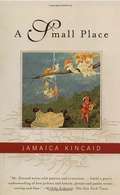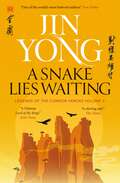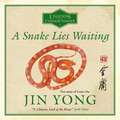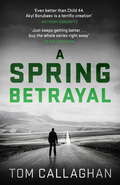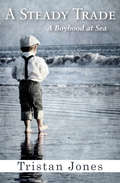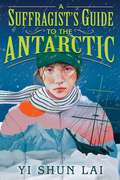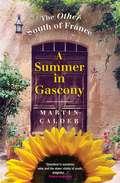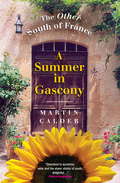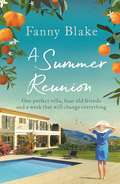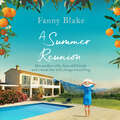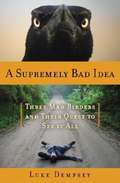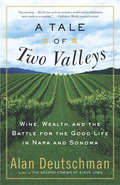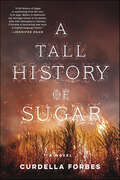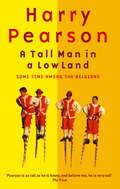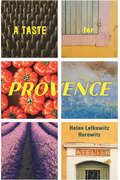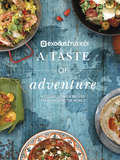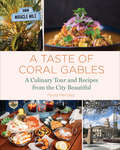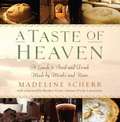- Table View
- List View
A Small Place
by Jamaica KincaidKincaid's book appraises the small island of Antigua in the British West Indies where she grew up and makes vivid the impact of European colonization and tourism.
A Small Town Love Story: Colonial Beach, Virginia
by Sherryl WoodsPart memoir, part oral history, #1 New York Times bestselling author Sherryl Woods gives us a rare and intimate look at Colonial Beach, Virginia.Rich in narrative history and local color, A Small Town Love Story: Colonial Beach, Virginia is an homage to the town of Sherryl Woods’s summers, a place that stole her heart long ago and provided the basis for the many fictional small towns in her bestselling novels.True to Woods’s signature style of focusing on characters who are at the center of their communities, here she has woven together the stories of the very real people who helped shape this seaside Virginia town. She takes us back to the days of her own family gatherings, artfully capturing the unique essence of Colonial Beach and making us yearn for small-town life.Woods’s own memories frame the true stories she features—from the unique history of Colonial Beach itself to some firsthand accounts of the Oyster Wars that once consumed the community, to the stories of neighborhood merchants who made it a point to know just about every customer by name. From farmers to restauranteurs and hoteliers, from pastors to librarians and military folk, Woods’s research and interviews give life to the personalities of a very special place.
A Snake Lies Waiting: Legends of the Condor Heroes Vol. 3 (Legends of the Condor Heroes #3)
by Jin YongTHE CHINESE "LORD OF THE RINGS" - NOW IN ENGLISH FOR THE FIRST TIME.THE SERIES EVERY CHINESE READER HAS BEEN ENJOYING FOR DECADES - 300 MILLION COPIES SOLD."Jin Yong's work, in the Chinese-speaking world, has a cultural currency roughly equal to that of "Harry Potter" and "Star Wars" combined" Nick Frisch, New Yorker"Like every fairy tale you're ever loved, imbued with jokes and epic grandeur. Prepare to be swept along." Jamie Buxton, Daily MailChina: 1200 A.D.Guo Jing has confronted Apothecary Huang, his sweetheart Lotus' father, on Peach Blossom Island, and bested the villainous Gallant Ouyang in three trials to win her hand in marriage.But now, along with his sworn brother, Zhou Botong of the Quanzhen Sect, and his shifu, Count Seven Hong, Chief of the Beggar Clan, he has walked into a trap. Tricked by Huang into boarding a unseaworthy barge, they will surely drown unless Lotus - who has overheard her father's plans - can find a way to save them.Yet even if they are to survive the voyage, great dangers lie in wait on the mainland. The Jin Prince Wanyan Honglie has gathered a band of unscrupulous warriors to aid him in his search for the lost writings of the Great Song patriot General Yue Fei. If he is successful, the Jin armies will gain the key to total victory over the Song Empire, condemning Guo Jing's countrymen to centuries of servitude.Translated from the Chinese by Anna Holmwood and Gigi Chang
A Snake Lies Waiting: Legends of the Condor Heroes Vol. 3 (Legends of the Condor Heroes)
by Jin YongTHE CHINESE "LORD OF THE RINGS" - NOW IN ENGLISH FOR THE FIRST TIME.THE SERIES EVERY CHINESE READER HAS BEEN ENJOYING FOR DECADES - 300 MILLION COPIES SOLD."Jin Yong's work, in the Chinese-speaking world, has a cultural currency roughly equal to that of "Harry Potter" and "Star Wars" combined" Nick Frisch, New Yorker"Like every fairy tale you're ever loved, imbued with jokes and epic grandeur. Prepare to be swept along." Jamie Buxton, Daily MailChina: 1200 A.D.Guo Jing has confronted Apothecary Huang, his sweetheart Lotus' father, on Peach Blossom Island, and bested the villainous Gallant Ouyang in three trials to win her hand in marriage.But now, along with his sworn brother, Zhou Botong of the Quanzhen Sect, and his shifu, Count Seven Hong, Chief of the Beggar Clan, he has walked into a trap. Tricked by Huang into boarding a unseaworthy barge, they will surely drown unless Lotus - who has overheard her father's plans - can find a way to save them.Yet even if they are to survive the voyage, great dangers lie in wait on the mainland. The Jin Prince Wanyan Honglie has gathered a band of unscrupulous warriors to aid him in his search for the lost writings of the Great Song patriot General Yue Fei. If he is successful, the Jin armies will gain the key to total victory over the Song Empire, condemning Guo Jing's countrymen to centuries of servitude.Translated from the Chinese by Anna Holmwood and Gigi Chang(P)2020 Quercus Editions Limited
A Social View of Socotra Island: People, Culture, Heritage
by Nataša Slak Valek Ahmad Abdelmoniem ZedanThis book focuses on Socotra Island, geographically based in Yemen, and aims to explore the island from the social sciences point of view. This book focuses on people indigenous to Socotra, Socotri cultures, heritage and also offers contributions from business, tourism, linguistic, communication, and anthropology. While a lot has been published in natural science about Socotra’s endemic species, biodiversity, and nature in general, social scientific research of the island is very limited. This book addresses therefore addresses this gap and explores various topics of tourism, behaviours, cultures, and language.This book focuses on a clear social science approach of Socotra. The purpose of this book is to publish research about the people, behaviors, heritage, and potential tourism of Socotra. The Socotra Archipelago has long been a land of mystery. It is unknown as a tourism destination for many, however, is a popular destination for adventurers, photographers and travelers who like to travel to remote and undeveloped places. This book explains how Socotra has limited resources of electricity, which is provided by diesel generators, Internet is very slow and limited to certain points on the island. There are no shopping malls or five-star hotels. Roads, schools, and hospitals have been built only recently. This book shoes how these island people do not know the development as we do, which makes it principally interesting to research. Previous interviewers of Socotri people about tourism development in the island have faced many challenges such as language barriers, lack of understanding the meanings and interviewing content, lack of support for the anticipated research results. This book successfully undertakes this challenge as not only in understanding the language, but understanding phenomena like e.g. tourism. Whilst acknowledging the ways in which indigenous island people have never travelled or seen a developed city. Thus, words like ‘developed’, ‘tourism destination’ or ‘washing machine’ may be unfamiliar terms for them. Therefore, new and innovative research methods that are sensitive to Socotra people were implemented in the creation of this book.
A Spring Betrayal: An Inspector Akyl Borubaev Thriller (2)
by Tom Callaghan'Even better than Child 44. Akyl Borubaev is a terrific creation' Anthony HorowitzWE UNCOVERED THE LAST OF THE BODIES IN THE RED HOUR BEFORE DUSK, AS THE SUN STAINED THE SNOWCAPS OF THE TIAN SHAN MOUNTAINS THE COLOUR OF DRIED BLOOD. . .Inspector Akyl Borubaev of Bishkek Murder Squad has been exiled to the far corner of Kyrgyzstan, but death still haunts him at every turn. Borubaev soon finds himself caught up in a mysterious and gruesome new case: several children's bodies have been found buried together - all tagged with name bands. In his search for the truth behind the brutal killings, Borubaev hits a wall of silence, with no one to turn to outside his sometime lover, the beautiful undercover agent Saltanat Umarova.When Borubaev himself is framed, accused of involvement in the production of blood-soaked child pornography, it looks as though things couldn't get any worse. With the investigation at a dangerous standstill, Borubaev sets out to save his own integrity, and to deliver his own savage justice on behalf of the many dead who can't speak for themselves . . .'Just keeps getting better . . . buy the whole series right away' Peter Robinson, No.1 bestselling author of Sleeping in the Ground'Storytelling of the highest quality . . . Introduces a detective it is impossible not to believe in. Callaghan is a new voice to be welcomed' Daily Mail
A Spring Betrayal: An Inspector Akyl Borubaev Thriller (2) (An Inspector Akyl Borubaev Thriller)
by Tom Callaghan'Even better than Child 44. Akyl Borubaev is a terrific creation' Anthony HorowitzWE UNCOVERED THE LAST OF THE BODIES IN THE RED HOUR BEFORE DUSK, AS THE SUN STAINED THE SNOWCAPS OF THE TIAN SHAN MOUNTAINS THE COLOUR OF DRIED BLOOD. . .Inspector Akyl Borubaev of Bishkek Murder Squad has been exiled to the far corner of Kyrgyzstan, but death still haunts him at every turn. Borubaev soon finds himself caught up in a mysterious and gruesome new case: several children's bodies have been found buried together - all tagged with name bands. In his search for the truth behind the brutal killings, Borubaev hits a wall of silence, with no one to turn to outside his sometime lover, the beautiful undercover agent Saltanat Umarova.When Borubaev himself is framed, accused of involvement in the production of blood-soaked child pornography, it looks as though things couldn't get any worse. With the investigation at a dangerous standstill, Borubaev sets out to save his own integrity, and to deliver his own savage justice on behalf of the many dead who can't speak for themselves . . .'Just keeps getting better . . . buy the whole series right away' Peter Robinson, No.1 bestselling author of Sleeping in the Ground'Storytelling of the highest quality . . . Introduces a detective it is impossible not to believe in. Callaghan is a new voice to be welcomed' Daily Mail
A Steady Trade: A Boyhood at Sea
by Tristan JonesA memoir of growing up in pre-World War II Wales and developing a love of sailing and adventure, by the author of The Incredible Voyage. Tristan Jones vividly and colorfully describes his childhood as a Welsh boy growing up by the sea. The story of his boyhood in pre-World War II England is strikingly charming and nostalgic. The challenges and adventures he encounters will have you seeing, smelling, feeling, hearing, and tasting the sea as you travel with him through this coming-of-age story.
A Suffragist's Guide to the Antarctic
by Yi Shun LaiA teen&’s fight for suffrage turns into one of survival when her crew&’s Antarctic expedition ship gets stuck in the ice in this historical novel told in journal entries perfect for fans of Gary Paulsen and The Downstairs Girl.November 1914. Clara Ketterling-Dunbar is one of twenty-eight crew members of The Resolute—a ship meant for an Antarctic expedition now marooned on ice one hundred miles from the shore of the continent. An eighteen-year-old American, Clara has told the crew she&’s a twenty-one-year-old Canadian. Since the war broke out, sentiment toward Americans has not been the most favorable, and Clara will be underestimated enough simply for being a woman without also giving away just how young she is. Two members of the crew know her nationality, but no one knows the truth of her activities in England before The Resolute set sail. She and her suffragist sisters in the Women&’s Social & Political Union were waging war of a different kind in London. They taught Clara to fight. And now, even marooned on the ice, she won&’t stop fighting for women&’s rights…or for survival. In the wilderness of Antarctica, Clara is determined to demonstrate what a woman is truly capable of—if the crew will let her.
A Suitcase Surprise for Mommy
by Cat CoraMommy must travel for business, and Zoran is not happy-he will miss her too much! But what if he gives Mommy one of his special things to take with her so that she will have a part of him with her when she goes? Like The Kissing Hand, this story offers a usable and comforting solution for kids and parents to help ease times of separation and show that out of sight does not mean out of mind or heart. Iron Chef and working mom Cat Cora and her son came up with this idea when she had to do her own work travel.
A Summer In Gascony: The Other South of France
by Martin CalderThe only travel writing book on Gascony, A Summer in Gascony is a charming and humorous tale of an extraordinary summer spent in this relatively unknown part of south-western France, the home of D Artagnan, Cyrano de Bergerac, gutsy red wine, fine sweet wine Armagnac and sunflowers. It is a tale of two love affairs: an idyllic summer romance and a lifelong love affair with Gascony with its village festivals, dusty roads and sun-baked wine country. Stretching from Toulouse in the east to the Atlantic coast in the west, from the river Garonne in the north to the Pyrenees in the south, Gascony is a golden land of rolling hills and wide horizons, swathed with vineyards, sunflowers, maize and pastures. It has a distinct identity which sets it apart from the rest of France and old affinities with England: the Gascons fought alongside the English in the Middle Ages and the Napoleonic Wars against their common foe the French. In the tiny hamlet of Peguilhan, Martin Calder is introduced to the Gascon way of life: working in the fields, shepherding and slaughtering sheep, feeding the cattle, harvesting the wheat, watering the crops. He discovers a unique people, fiercely proud of their independent heritage. Full of colourful characters: the charismatic and convivial Jacques-Henri, the hardworking farmer whose family take Martin into their home and hearts; the yoga-practising Germans; Pattes, the mischievous stray dog; Madame Parle-Beaucoup , the town gossip and Monsieur Fustignac, whose pride in his Gascon heritage is unforgettable. But the real star of the book is Gascony itself, with its strong spirit of independence and the simple pleasures it provides. Written by a true Francophile who has come to know the people and understands their way of life, A Summer in Gascony evokes the spirit, sights, smells and sounds of this still relatively unknown and unspoiled other South of France.
A Summer In Gascony: The Other South of France
by Martin CalderThe only travel writing book on Gascony, A Summer in Gascony is a charming and humorous tale of an extraordinary summer spent in this relatively unknown part of south-western France, the home of D Artagnan, Cyrano de Bergerac, gutsy red wine, fine sweet wine Armagnac and sunflowers. It is a tale of two love affairs: an idyllic summer romance and a lifelong love affair with Gascony with its village festivals, dusty roads and sun-baked wine country. Stretching from Toulouse in the east to the Atlantic coast in the west, from the river Garonne in the north to the Pyrenees in the south, Gascony is a golden land of rolling hills and wide horizons, swathed with vineyards, sunflowers, maize and pastures. It has a distinct identity which sets it apart from the rest of France and old affinities with England: the Gascons fought alongside the English in the Middle Ages and the Napoleonic Wars against their common foe the French. In the tiny hamlet of Peguilhan, Martin Calder is introduced to the Gascon way of life: working in the fields, shepherding and slaughtering sheep, feeding the cattle, harvesting the wheat, watering the crops. He discovers a unique people, fiercely proud of their independent heritage. Full of colourful characters: the charismatic and convivial Jacques-Henri, the hardworking farmer whose family take Martin into their home and hearts; the yoga-practising Germans; Pattes, the mischievous stray dog; Madame Parle-Beaucoup , the town gossip and Monsieur Fustignac, whose pride in his Gascon heritage is unforgettable. But the real star of the book is Gascony itself, with its strong spirit of independence and the simple pleasures it provides. Written by a true Francophile who has come to know the people and understands their way of life, A Summer in Gascony evokes the spirit, sights, smells and sounds of this still relatively unknown and unspoiled other South of France.
A Summer Reunion: The perfect beach book to read on holiday this summer
by Fanny Blake'A lovely holiday read about female friendships past and present. Warm and engaging' Catherine AlliottOne perfect villa, four old friends, and a holiday that will change everything...Amy, Linda, Kate and Jane were best friends at school. Now, years later, they have grown apart. When Amy discovers her husband has been stealing from her successful interiors business, and with a milestone birthday looming, she decides it is the time to reach out to her old friends once again. So, she decides to invite the other three to her beautiful villa in Mallorca for a reunion weekend. As the four friends gather, secrets are unearthed, old scores settled and new friendships forged. Will this holiday bring them together or tear them apart? And will each of them grasp their second chance for happiness...?'A warm and uplifting read. I really enjoyed it' Rosanna Ley, author of The Lemon Tree Hotel'A skilfully woven story of old friendships, secrets and lies set against the sun-soaked backdrop of Mallorca. The ideal summer read' Sarah Morgan, author of One Summer in Paris'A fantastic read from one of our favourite authors' Bella'An insightful look at female friendship with a beautiful sunny backdrop' Sunday Express'A great summer read, with relatable characters, an engaging plot and a satisfying ending' WI Life
A Summer Reunion: The perfect beach book to read on holiday this summer
by Fanny Blake'A lovely holiday read about female friendships past and present. Warm and engaging' Catherine AlliottOne perfect villa, four old friends, and a holiday that will change everything...Amy, Linda, Kate and Jane were best friends at school. Now, years later, they have grown apart. When Amy discovers her husband has been stealing from her successful interiors business, and with a milestone birthday looming, she decides it is the time to reach out to her old friends once again. So, she decides to invite the other three to her beautiful villa in Mallorca for a reunion weekend. As the four friends gather, secrets are unearthed, old scores settled and new friendships forged. Will this holiday bring them together or tear them apart? And will each of them grasp their second chance for happiness...?'A warm and uplifting read. I really enjoyed it' Rosanna Ley, author of The Lemon Tree Hotel'A skilfully woven story of old friendships, secrets and lies set against the sun-soaked backdrop of Mallorca. The ideal summer read' Sarah Morgan, author of One Summer in Paris'A fantastic read from one of our favourite authors' Bella'An insightful look at female friendship with a beautiful sunny backdrop' Sunday Express'A great summer read, with relatable characters, an engaging plot and a satisfying ending' WI Life
A Summer Reunion: The perfect escapist read
by Fanny BlakeAmy, Anne, Kate and Jane were best friends at school. But now, as they approach their sixtieth birthdays, their lives have taken them in different directions. Successful, dissatisfied, seeking something different in equal measure, they know that life is not always easy. So when Amy invites the other three to her beautiful villa in Majorca for a long celebratory reunion weekend, each of them is drawn by curiosity... and each has a reason for wanting to get away from home for a while. Against the backdrop of the stunning Mallorcan hills, the four friends will look back over their lives - the choices they made, the families they have built - and they'll reassess what is important to them and whether now is the time to grasp those second chances, or whether this reunion will change everything...(p) Orion Publishing Group 2019
A Summer in Gascony, New Edition
by Martin CalderGascony's incredible culture and beautiful landscape shine as Martin Calder is introduced to "the other South of France." In the tiny hamlet of Peguilhan, Martin discovers the unique personalities of Jacques-Henri (the hardworking farmer), Anja (the lovely German student), Pattes (a trouble-making stray dog), and more-including the town gossip and a man with incredible Gascon heritage.
A Supremely Bad Idea: Three Mad Birders and Their Quest to See It All
by Luke DempseyIt was an epiphany: The moment two friends showed Luke Dempsey a small bird flitting around the bushes of his country garden, he fell madly in love. But did he really want to be a birder? Didn't that mean he'd be forced to eat granola? And wear a man-pouch? Before he knew it, though, he was lost to birding mania. Early mornings in Central Park gave way to weekend mornings wandering around Pennsylvania, which morphed into week-long trips to Texas, Arizona, Michigan, Florida--anywhere the birds were. A Supremely Bad Idea is one man's account of an epic journey around America, all in search of the rarest and most beautiful birds the country has to offer. But the birds are only part of it. There are also his crazy companions, Don and Donna Graffiti, who obsess over Dempsey's culinary limitations and watch in horror as an innocent comment in a store in Arizona almost turns into an international incident; as a trip through wild Florida turns into a series of (sometimes poetic) fisticuffs; and as he teeters at the summit of the Rocky Mountains, a displaced Brit falling in love all over again, this time with his adopted country. Both a paean to avian beauty and a memoir of the back roads of America, A Supremely Bad Idea is a supremely fun comic romp: an environmentally sound This Is Spinal Tap with binoculars.
A Tale of Two Valleys: Wine, Wealth and the Battle for the Good Life in Napa and Sonoma
by Alan DeutschmanWhen acclaimed journalist Alan Deutschman came to the California wine country as the lucky house guest of very rich friends, he was surprised to discover a raging controversy. A civil war was being fought between the Napa Valley, which epitomized elitism, prestige and wealthy excess, and the neighboring Sonoma Valley, a rag-tag bohemian enclave so stubbornly backward that rambunctious chickens wandered freely through town. But the antics really began when new-money invaders began pushing out Sonoma’s poets and painters to make way for luxury resorts and trophy houses that seemed a parody of opulence. A Tale of Two Valleys captures these stranger-than-fiction locales with the wit of a Tom Wolfe novel and uncorks the hilarious absurdities of life among the wine world’s glitterati.Deutschman found that on the weekends the wine country was like a bunch of gracious hosts smiling upon their guests, but during the week the families feuded with each other and their neighbors like the Hatfields and McCoys. Napa was a comically exclusive club where the super-rich fought desperately to get in. Sonoma’s colorful free spirits and iconoclasts were wary of their bohemia becoming the next playground for the rapacious elite. So, led by a former taxicab driver and wine-grape picker, a cheese merchant, and an artist who lived in a barn surrounded by wild peacocks, they formed a populist revolt to seize power and repel the rich invaders.Deutschman’s cast of characters brims with eccentrics, egomaniacs, and a mysterious man in black who crashed the elegant Napa Valley Wine Auction before proceeding to pay a half-million dollars for a single bottle. What develops is nothing less than a battle for the good life, a clash between old and new, the struggle for the soul of one of America’s last bits of paradise. A dishy glimpse behind the scenes of a West Coast wonderland, A Tale of Two Valleys makes for intoxicating reading.
A Tall History of Sugar: A Novel
by Curdella ForbesA haunting, epic Caribbean love story, reminiscent of García Márquez's Love in the Time of Cholera.Winner of the 2020 Hurston/Wright Legacy Award for Fiction“A Tall History of Sugar is a gift for grown-up fans of fairy tales and those who love fiction that metes out hard and surprising truths. Forbes’s writing combines the gale-force imagination of Margaret Atwood with the lyrical pointillism of Toni Morrison.” —New York Times Book Review, Editors’ ChoiceA Tall History of Sugar tells the story of Moshe Fisher, a man who was “born without skin,” so that no one is able to tell what race he belongs to; and Arrienne Christie, his quixotic soul mate who makes it her duty in life to protect Moshe from the social and emotional consequences of his strange appearance.The narrative begins with Moshe’s birth in the late 1950s, four years before Jamaica’s independence from colonial rule, and ends in the era of what Forbes calls “the fall of empire,” the era of Brexit and Donald Trump. The historical trajectory layers but never overwhelms the scintillating love story as the pair fight to establish their own view of loving, against the moral force of the colonial “plantation” and its legacies that continue to affect their lives and the lives of those around them.Written in lyrical, luminous prose that spans the range of Jamaican Englishes, this remarkable story follows the couple’s mysterious love affair from childhood to adulthood, from the haunted environs of rural Jamaica to the city of Kingston, and then to England—another haunted locale in Forbes’s rendition.
A Tall Man In A Low Land: Some Time Among the Belgians
by Harry PearsonMost British travel writers head south for a destination that is hot, exotic, dangerous or all three. Harry Pearson chose to head in the opposite direction for a country which is damp, safe and of legendary banality: Belgium. But can any nation whose most famous monument is a statue of a small boy urinating really be that dull? Pearson lived there for several months, burying himself in the local culture. He drank many of the 800 different beers the Belgians produce; ate local delicacies such as kip kap (jellied pig cheeks) and a mighty tonnage of chicory and chips. In one restaurant the house speciality was 'Hare in the style of grandmother'. 'I didn't order it. I quite like hare, but had no wish to see one wearing zip-up boots and a blue beret.' A TALL MAN IN A LOW LAND commemorates strange events such as The Festival of Shrimps at Oostduinkerke and laments the passing of the Underpant Museum in Brussels. No reader will go away from A TALL MAN IN A LOW LAND without being able to name at least ten famous Belgians. Mixing evocative description and low-grade buffoonery Harry Pearson paints a portrait of Belgium that is more rounded than a Smurf after a night on the mussels.
A Tall Man In A Low Land: Some Time Among the Belgians
by Harry PearsonMost British travel writers head south for a destination that is hot, exotic, dangerous or all three. Harry Pearson chose to head in the opposite direction for a country which is damp, safe and of legendary banality: Belgium. But can any nation whose most famous monument is a statue of a small boy urinating really be that dull? Pearson lived there for several months, burying himself in the local culture. He drank many of the 800 different beers the Belgians produce; ate local delicacies such as kip kap (jellied pig cheeks) and a mighty tonnage of chicory and chips. In one restaurant the house speciality was 'Hare in the style of grandmother'. 'I didn't order it. I quite like hare, but had no wish to see one wearing zip-up boots and a blue beret.' A TALL MAN IN A LOW LAND commemorates strange events such as The Festival of Shrimps at Oostduinkerke and laments the passing of the Underpant Museum in Brussels. No reader will go away from A TALL MAN IN A LOW LAND without being able to name at least ten famous Belgians. Mixing evocative description and low-grade buffoonery Harry Pearson paints a portrait of Belgium that is more rounded than a Smurf after a night on the mussels.
A Taste for Provence
by Helen Lefkowitz HorowitzProvence today is a state of mind as much as a region of France, promising clear skies and bright sun, gentle breezes scented with lavender and wild herbs, scenery alternately bold and intricate, and delicious foods served alongside heady wines. Yet in the mid-twentieth century, a travel guide called the region a "mostly dry, scrubby, rocky, arid land." How, then, did Provence become a land of desire--an alluring landscape for the American holiday? In A Taste for Provence, historian Helen Lefkowitz Horowitz digs into this question and spins a wonderfully appealing tale of how Provence became Provence. The region had previously been regarded as a backwater and known only for its Roman ruins, but in the postwar era authors, chefs, food writers, visual artists, purveyors of goods, and travel magazines crafted a new, alluring image for Provence. Soon, the travel industry learned that there were many ways to roam--and some even involved sitting still. The promise of longer stays where one cooked fresh food from storied outdoor markets became desirable as American travelers sought new tastes and unadulterated ingredients. Even as she revels in its atmospheric, cultural, and culinary attractions, Horowitz demystifies Provence and the perpetuation of its image today. Guiding readers through books, magazines, and cookbooks, she takes us on a tour of Provence pitched as a new Eden, and she dives into the records of a wide range of visual media--paintings, photographs, television, and film--demonstrating what fueled American enthusiasm for the region. Beginning in the 1970s, Provence--for a summer, a month, or even just a week or two--became a dream for many Americans. Even today as a road well traveled, Provence continues to enchant travelers, armchair and actual alike.
A Taste of Adventure
by Exodus Travels LimitedIf you're an adventurer with an appetite, then this cookbook is for you! This lovely cookbook is a collection of globetrotting gastronomy to help you recreate your travels at home.The recipes in this book are from all over the world, from Vietnamese Pho and Indian Mango Lassi, to traditional African flatbreads, Middle Eastern Lamb Tagine, and Spanish Paella.With these recipes you'll have the whole world at your fingertips!
A Taste of Coral Gables: Cookbook and Culinary Tour of the City Beautiful
by Paola MendezThis ultimate foodie guide to the Florida city “features more than 70 restaurants, and the recipes reflect the diverse, multicultural culinary landscape” (Mitch & Mel Take Miami).A Taste of Coral Gables is brimming with all the great food and good vibes that make this sunny city in South Florida such a magnet for food lovers of all stripes. Filled with recipes, restaurant descriptions, menu highlights, chef profiles, wine pairings, and more, this one-stop resource on the Coral Gables food scene doubles as a restaurant guide and recipe resource to the best places the city has to offer.There are approximately seventy-five restaurants covered in the book, each with a two-page spread that contains color photographs, informative text on the origins and highlights of the restaurant, what makes it unique, and who the people are behind the restaurant’s unique atmosphere and cuisine. Each also features a recipe for one of the restaurant’s signature dishes for easy preparation at home.From such venerable dining establishments as the Palm d’Or at the Biltmore (haute cuisine in Old-World charm with New World sensibilities) to fun and funky specialty joints such as Ms. Cheezious (grilled cheese in every manner imaginable), to ethnic standouts such as Talavera (down-home Mexican), all bases are covered in this comprehensive culinary treasure trove paying homage to the “City Beautiful.”
A Taste of Heaven
by Madeline ScherbA fascinating (and mouthwatering!) look at the wonderful food and drink produced by monks and nuns in America, Belgium, France, and Germany. Part travel guide, part cookbook, A Taste of Heaven is a delightful survey of the fine food and drink made by Catholic religious orders in America, Belgium, France, and Germany. From positively scrumptious beer and cheese to some of the richest chocolate on earth, the treats presented in this book are heavenly indeed, and author Madeline Scherb beautifully captures the heart and spirit of the holy work that goes into producing them. With vivid descriptions of the monasteries, their fascinating histories, and helpful advice for travelers on getting there and getting the most out of their visit, this book will serve as an invaluable guide. A Taste of Heaven also contains more than thirty recipes from notable chefs that incorporate the products found at these monasteries, as well as a helpful guide to buying and ordering these delectable ingredients if you are unable to travel to the monasteries themselves. Recipes include such delights as: * Flamiche (a Belgian version of quiche that uses Postel cheese from the Postel Abbey in Belgium) from chef and food columnist Sandy D'Amato * Brownies à la Mode with Trappistine Caramel Sauce (uses caramel from Our Lady of the Mississippi Abbey, Iowa) * Blackberry Cabernet Sorbet (made with Pinot Noir from St. Hildegard Abbey near Rudesheim, Germany) from Ciao Bella Gelateria in Grand Central Terminal, New York City Featuring lovely original black-and-white illustrations that perfectly capture the tranquil atmosphere of the monasteries, A Taste of Heaven is a treasure for anyone who loves spirited food, drink, and travel. .
